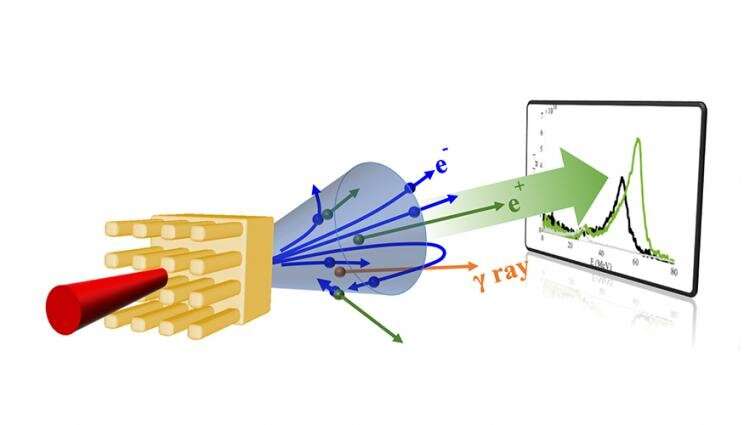
Lawrence Livermore National Laboratory (LLNL) scientists have achieved a near 100 percent increase in the amount of antimatter created in the laboratory.
Using targets with micro-structures on the laser interface, the team shot a high-intensity laser through them and saw a 100 percent increase in the amount of antimatter (also known as positrons). The research appears in Applied Physics Letters.
Previous research using a tiny gold sample created about 100 billion particles of antimatter. The new experiments double that.
"These successful experimental results are important for the Livermore positron project, whose grand goal is to make enough electron-positron antimatter to study the physics of gamma-ray bursts," said Hui Chen, the project lead and a co-author of the paper. "But we found that the experiments also created a high energy (MeV) X-ray backlighter that can penetrate very dense objects, which is important for many aspects of high energy density science."
When enough energy is squeezed into a very small space, such as during high-energy particle collisions, particle-antiparticle pairs are produced spontaneously. When energy transforms into mass, both matter and antimatter are created in equal amounts. In these experiments, intense laser-plasma interactions produce very high energy electrons whose energy, when interacting with the gold target, can generate electron-positron pairs.
The researchers used previous results and new simulations to design micro-structures, which could either enhance or diminish this interaction, leading to enhanced or suppressed positron generation relative the previous state of the art. Co-author Anthony Link said that "the agreement between the simulations and the experiment is remarkable, giving us confidence that we're capturing the most important physical mechanisms."
The ability to create numerous positrons in a small laboratory opens the door to new avenues of anti-matter research, including an understanding of the physics underlying various astrophysical phenomena such as black holes and gamma-ray bursts as well as a pathway toward a dense electron-positron plasma in the laboratory.
"Adding front surface micro-structures to the typical gold target constitutes a cost-effective approach to substantially increase the positron yield while keeping the same laser conditions. It is one step further toward using laser-generated positron sources for the variety of applications," said Jiang Sheng, the lead author of the paper.
Explore further
Citation: Doubling creation of antimatter using same laser energy (2021, March 4) retrieved 4 March 2021 from https://ift.tt/3sPrg6k
This document is subject to copyright. Apart from any fair dealing for the purpose of private study or research, no part may be reproduced without the written permission. The content is provided for information purposes only.
"creation" - Google News
March 04, 2021 at 07:57PM
https://ift.tt/3sPrg6k
Doubling creation of antimatter using same laser energy - Phys.org
"creation" - Google News
https://ift.tt/39MUE4f
https://ift.tt/3bZVhYX
Bagikan Berita Ini














0 Response to "Doubling creation of antimatter using same laser energy - Phys.org"
Post a Comment